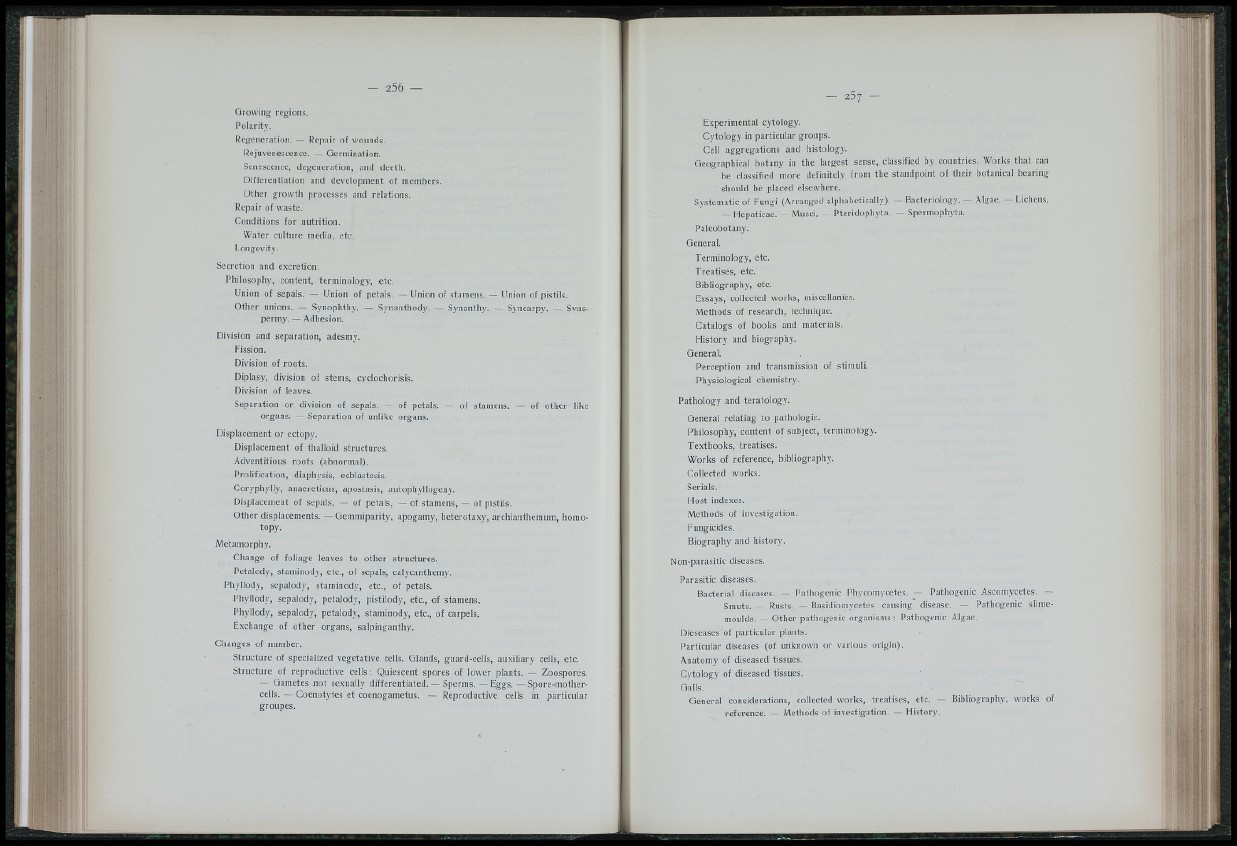
Growing regions.
Polarity.
Regeneration. — Repair of wounds.
Rejuvenescence. — Germination.
Senescence, degeneration, and deeth.
Differentiation and development of members.
Gther growth processes and relations.
Repair of waste.
Conditions for nutrition.
Water culture media, etc.
Longevity.
Secretion and excretion.
Philosophy, content, terminology, etc.
Union of sepals. — Union of petals. — Union of stamens. — Union of pistils.
Gther unions. — Synophthy. — Synanthody. — Synanthy. — Syncarpy. — Svns-
permy. — Adhesion.
Division and separation, adesmy.
Fission.
Division of roots.
Diplasy, division of stems, cyclochorisis.
Division of leaves.
Separation or division of sepals. — of petals. — of stamens. — of other like
organs. — Separation of unlike organs.
Displacement or ectopy.
Displacement of thalloid structures.
Adventitious roots (abnormal).
Prolification, diaphysis, ecblastesis.
Coryphylly, anaereticus, apostasis, aiitophyllogeny.
Displacement of sepals, — of petals, — of stamens, — of pistils.
Gther displacements. — Qemmiparity, apogamy, heterotaxy, archianthemum, homo-
topy.
Metamorphy.
Change of foliage leaves to other structures.
Petalody, staminody, etc., of sepals, calycanthemy.
Phyllody, sepalody, staminody, etc., of petals.
Phyllody, sepalody, petalody, pistilody, etc., of stamens.
Phyllody, sepalody, petalody, staminody, etc., of carpels.
Exchange of other organs, salpinganthy.
Changes of number.
Structure of specialized vegetative cells. Glands, guard-cells, auxiliary cells, etc.
Structure of reproductive c e l l s : Quiescent spores of lower plants. — Zoospores.
— Gametes not sexually differentiated. — Sperms. — Eggs. — Spore-mother-
cells. — Coenotytes et coenogametus. — Reproductive cells in particular
groupes.
Experimental cytology.
Cytology in particular groups.
Cell aggregations and histology.
Geographical botany in the largest sense, classified by countries. Works that can
be classified more definitely from the standpoint of their botanical bearing
should be placed elsewhere.
Systematic of Fungi (Arranged alphabetically). — Bacteriology. — Algae. - - Lichens.
— Hepaticae. - Musci. - Pteridophyta. - - Spermophyta.
Paleobotany.
General.
Terminology, etc.
Treatises, etc.
Bibliography, etc.
Essays, collected works, miscellanies.
Methods of research, technique.
Catalogs of books and materials.
History and biography.
General.
Perception and transmission of stimuli.
Physiological chemistry.
Pathology and teratology.
General relating to pathologie.
Philosophy, content of subject, terminology.
Textbooks , treatises.
Works of reference, bibliography.
Collected works.
Serials.
Hos t indexes.
Methods of investigation.
Fungicides.
Biography and history.
Non-parasitic diseases.
Parasitic diseases.
Bacterial diseases. — Pathogenic Phycomycetes. — Pathogenic Ascomycetes. —
Smuts. — Rusts. — Basidiomycètes causing disease. — Pathogenic slime-
moulds. — Gther pathogenic organisms: Pathogenic Algae.
Dieseases of particular plants.
Particular diseases (of unknown or various origin).
Anatomy of diseased tissues.
Cytology of diseased tissues.
Galls.
General considerations, collected works, treatises, etc. — Bibliography, works of
reference. — Methods of investigation. — History.
n